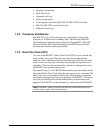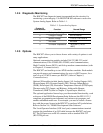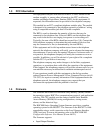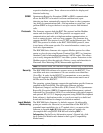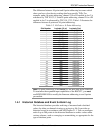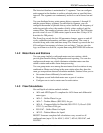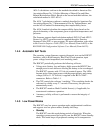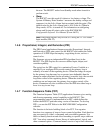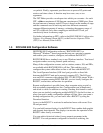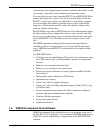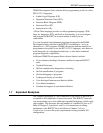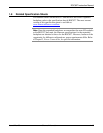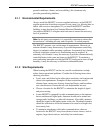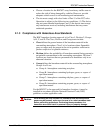
ROC827 Instruction Manual
Issued Mar-06 General Information 1-14
the user. The ROC827 wakes from Standby mode when it needs to
perform a task.
Sleep
The ROC827 uses this mode if it detects a low battery voltage. The
System AI Battery Point Number 1 measures the battery voltage and
compares it to the LoLo Alarm limit associated with this point. (The
default value for the LoLo Alarm limit is 10.6 Volts dc.) When in
Sleep mode, AUX
sw
is turned off. For information on configuring
alarms and System AI points, refer to the ROCLINK 800
Configuration Software User Manual (Form A6121).
Note: Sleep mode applies only to ROC827s using the 12 V dc Power
Input module (PM-12).
1.4.6 Proportional, Integral, and Derivative (PID)
The PID Control applications firmware provides Proportional, Integral,
and Derivative (PID) gain control for the ROC827 and enables the stable
operation of 16 PID loops that employ a regulating device, such as a
control valve.
The firmware sets up an independent PID algorithm (loop) in the
ROC827. The PID loop has its own user-defined input, output, and
override capability.
The typical use for PID control is to maintain a Process Variable at a
setpoint. If you configure PID override control, the primary loop is
normally in control of the regulating device. When the change in output
for the primary loop becomes less or greater (user-definable) than the
change in output calculated for the secondary (override) loop, the override
loop takes control of the regulating device. When the switchover
conditions are no longer met, the primary loop regains control of the
device. Parameters are also available to force the PID into either loop or
force it to stay in one loop.
1.4.7 Function Sequence Table (FST)
The Function Sequence Table (FST) applications firmware gives analog
and discrete sequencing control capability to the ROC827. This
programmable control is implemented in an FST, which defines the
actions the ROC827 performs using a series of functions. To develop
FSTs, you use the FST Editor in the ROCLINK 800 Configuration
software.
The function is the basic building block of an FST. You organize
functions in a sequence of steps to form a control algorithm. Each function
step can consist of a label, a command, and associated arguments. Use
labels to identify functions and allow branching to specific steps within an
FST. You select commands from a library of mathematical, logical, and
other command options. Command names consist of up to three characters



